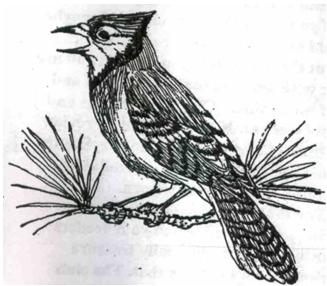Common Birds
About the Blue Jay
 The Blue Jay and the Crow have the reputation of being the sentinels for danger in the world of birds. When a flock of noisy Jays come into your feeding area, most birds scatter or bead for cover. Many think it is the Jay itself that causes this. Occasionally they may sound the alarm to free-up space for themselves at over crowded feeders, but more often it is a call that alarms not only other birds in the area but many mammals in the vicinity of a nearby predator such as a hawk, fox, or cat. Squirrels will rush for the trees and even deer seem startled by the alarm. Although Blue Jays are considered nest robbers, the warning system they provide may be a trade off. This business of nest robbing, which occurs with Jays, Crackles and Crows, is the easiest solution for them to acquire the nutrients they need for developing their own eggs. Many folks provide finely ground Oyster shell or dried and crushed egg shells which are readily taken by all nesting birds and fill the same nutritional needs.
The Blue Jay and the Crow have the reputation of being the sentinels for danger in the world of birds. When a flock of noisy Jays come into your feeding area, most birds scatter or bead for cover. Many think it is the Jay itself that causes this. Occasionally they may sound the alarm to free-up space for themselves at over crowded feeders, but more often it is a call that alarms not only other birds in the area but many mammals in the vicinity of a nearby predator such as a hawk, fox, or cat. Squirrels will rush for the trees and even deer seem startled by the alarm. Although Blue Jays are considered nest robbers, the warning system they provide may be a trade off. This business of nest robbing, which occurs with Jays, Crackles and Crows, is the easiest solution for them to acquire the nutrients they need for developing their own eggs. Many folks provide finely ground Oyster shell or dried and crushed egg shells which are readily taken by all nesting birds and fill the same nutritional needs.
Raucous flocks of Blue Jays have always reminded me of a bunch of unruly teenagers, bent on having a good time. They are especially noisy in late winter and spring. When they are paired and courting, prior to nest building, they become very quiet and stealthy. They lurk through the forests like blue ghosts, barely making a sound. When the nest is built and the eggs are laid, they seem to become their noisy selves once again.
Blue Jays like to build their nests in evergreens, about ten to twenty feet up. The nest consists of twigs, grasses and many unusual things including cellophane, cloth and other man made articles. The normal clutch is four or five eggs, which take seventeen days to hatch. The female tends to the young for several days while the male feeds her on the nest. Both will feed after the brooding stage with the nestling phase lasting seventeen to nineteen days. The family unit stays together for several months and the young will often beg for food well into late summer.
Many ask how to tell the sexes apart? They look identical to us, but they obviously know the difference. There are two times when we can tell them apart and the first is, when the early spring chases ensue. A number of noisy Blue Jays w ill be frying about and the lead bird will be the female, followed by her suitors. The other is if you are lucky enough to find a nest, it will be the female alone that incubates the eggs.
Blue Jays are partial migrants. Some may stay here year around, while other years they may be sparse. A poor acorn crop will force many to migrate to better food sources south of us. These birds will then return about the first of April, to start this whole nesting thing all over again.
Contributed by Mr. Weir Nelson of Wildlife Habitat, Cedar Rapids, Iowa
Published by The Wild Bird Habitat Store
